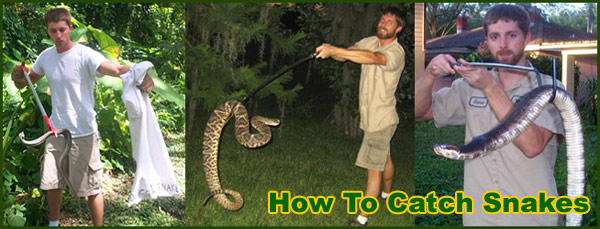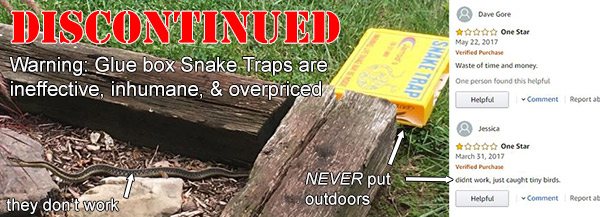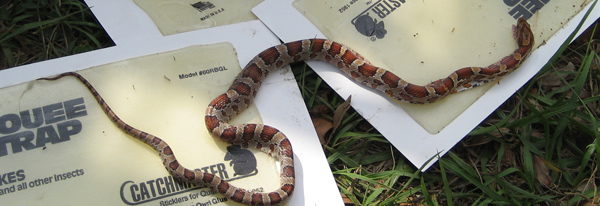- info@wildlife-removal.com
Call us for help in your town
Wildlife Removal Education
How To Trap Snakes - Humanely
Need snake removal in your hometown? We service over 500 USA locations! Click here to hire us in your town and check prices - updated for year 2020.
Option 1 - You can hire a professional in your area. Look on the internet for a company, or your local yellow pages, or you can find someone in your town from my directory of
1500 snake experts serving every US city and town that I list on this website.
This method is the most reliable, but the priciest.
Option 2 - You can purchase a snake trap. These rarely work, they are very inhumane if set outdoors, and are overpriced (just a glue board in a box). I used to sell them, but I quit after I learned
how bad they are. If you do want to buy a trap, I recommend a cage style minnow trap.
Option 3 - You can catch it yourself. However, this can be risky for novices - almost ALL cases of snakebites occur when people attempt to catch or kill snakes. Read more about
snake safety tips here.
Click here for my nationwide list of 100's of professional snake trappers serving all 50 states.

Snake trap -
There are many styles of snake traps on the market. Some work and some do not. One of the most popular models is the snake trap glue box, which operates on the premise that snakes will be lured to the plastic box by the use of scent lures inside.
Once the animal enters, the glue on the bottom of the trap will hold it firmly in place. Because this trap will hold a snake and keep it alive, you need to make sure you check the trap daily. NEVER set such a trap outside, where it can catch and kill
birds or mammals or even the paws of cats and cause suffering. There is no need to let the snake suffer inside, unable to move.
The trap is mobile enough to be carried to a relocation area. To release the snake, vegetable oil is poured into the trap. The oil will de-stick the glue and the snake will be able to free itself. Many experts recommend the use of live traps for all types
of snakes. Despite the fear factor involved with the serpents, snakes are very helpful in the war against other nuisance animals like rodents. A snake in your yard will only startle you; a rat in your house will rip apart the insulation and destroy electric
wires. Be kind to the snakes. These animals do a lot more for homeowners than the average person realizes.

How to trap a snake -
There are many different models of snake traps available. Most are lethal body gripping traps. You can kill the snakes in your yard; however, snakes are far more beneficial than you might realize. A snake around your home will keep a good eye on insects and rodents. It is much worse to have a rat sneak into your home than to have a snake in your yard. The snake will cause no property damage, and if it is nonvenomous, you do not have to worry about children and pets. One of the most effective traps on the market is the glue trap. This works for snakes of many species and sizes. The glue pad is covered by a plastic box. Scent lures will draw the snake inside through a specially designed opening. To get out, the snake must enter fully and turn around. Once the reptile is inside, the glue holds it firmly in place. Glue traps can be fairly hands-free. You can release the snake by spraying cooking oil on the glue pad. It may take a few minutes, but the snake will eventually slither free. This is a good way to relocate a problem snake without having to kill it.
Where to buy snake traps -
It is not hard to locate a dealer of snake traps, regardless of whether you live in Easley, SC or Binghamton, NY. In fact, one of the best snake traps is available to residence of in both those locations through an online directory. You can usually find local hardware store with snake traps, but the online site provide the latest and greatest when it comes to glue traps. The nice thing about the snake trap glue box is that it does not kill the snake. People forget how beneficial snakes are to our environment. Instead, homeowners only see the squirmy, unappealing side to serpents. Glue traps draw the snake inside through the use of rodent oil lures. Once in the box, the serpent is unable to turn back toward the exit without becoming completely stuck on the glue pad. To release the snake, all you need to do is spray the animal and the glue with cooking oil. The glue will be neutralized, and the snake will be able to wiggle free after a few minutes.
Here are some other snake links:
How To Trap Snakes
What Animals Kill Snakes
Color Rhyme for Coral Snakes
How Can You Tell if a Snake is Poisonous
How to Kill Snakes
Snakebite Aftercare
Snake Safety Tips
How to Catch Snakes
How Do You Keep Snakes Away
Do Mothballs Keep Away Snakes
Eastern Coral Snake
Eastern Diamondback Rattlesnake
Snakes in the Attic
Photographs of Snake Poop
Should You Relocate A Trapped Snake?
Trying to find a good location where you can release a snake that you have caught in a trap can be difficult, and while you cannot always find a location that ticks all the boxes, try to find one that offers the best chance possible of survival to the snake. In most cases you will need to travel to relocate a snake, as you will not want it being moved to an area too close to your property, otherwise it is likely to return. Here are a few tips on finding the best location in your area to relocate the pest animal.

Locations Away From Human Habitation
One of the key features that you are looking for when choosing a relocation spot is that it should be away from human habitation, and preferably away from areas where humans are seen regularly. Ultimately, you do not want to pass on your snake problem to someone else, and the best chance for the snake to survive is in areas where it will not be getting regular human contact.
Look For Somewhere With A Good Natural Habitat
When you are looking for a spot where you can release a snake safely, then try to think about the kind of habitat the species likes, and the type of prey that the snake is best at hunting. An area that provides similar terrain and similar animal species to hunt will often provide a great habitat for the snake, and knowing that you have given the animal a chance of survival is as much reassurance as you can expect when dealing with pest animals.
Relocating A Venomous Snake
If you realize after catching a snake that it might be venomous, then you do need to be very careful when you are relocating the animal. Make sure that you have a good space to retreat to once you have released the animal, and be certain to place the trap in a sealed cage or a box that will ensure the snake cannot escape during transportation. It may be worth getting a professional to carry out the relocation.
Do Relocated Snakes Die?
There are many different species of pest animals, and while some are largely dependent on the knowledge about their habitat to survive, snakes are actually very adaptable. Unlike many species that tend to die soon after relocation, snakes actually have a very good chance of survival following such a relocation.
Can You Catch A Snake Using Traps?
The brief answer to this particular question is that yes, there are plenty of people who use snake traps to catch snakes of all sizes and varieties that are causing problems in their areas. However, these traps will often be more successful if you are trying to deal with smaller species of snakes, as larger snakes in a trap can be difficult to move, while catching venomous snakes in such traps can pose a little extra danger when it comes to relocating and releasing them.

Glue Based Snake Traps
The first type of snake trap that is commonly available is the glue trap, and here you will have a box, which has an adhesive layer on the bottom of the box, and when the snake slithers in to the trap, it actually becomes stuck inside. Once you have decided what to do with the snake, you can release it from the tap by pouring harmless vegetable oil over the snake and the adhesive, and this will then allow the snake to move away from the trap safely.
Maze Traps
This is a different type of trap, but still one that is contained within a box, but instead of adhesive, inside the box is a corridor with a series of turns that encourages the snake to continue forwards through the maze. Once inside, the snake is unable to move backwards, and becomes stuck in the trap, which can then be transported to the release location, where the lid can be taken off and the snake can be released.
Can You Bait A Snake Trap?
While you can use traps to catch snakes, it is unlikely that you will be able to successfully bait a snake trap, as snakes will only eat live prey, and keeping a live mouse or insects in a trap can be quite a problem. The location is usually the most important thing to remember when trapping snakes, and as they are fond of slithering along edges, then placing them at the bottom of a wall or fence will often be the most successful approach.
Alternative Ways Of Dealing With A Snake Infestation
If you have considered using traps, and they are not appropriate, then there are certain other measures that you can carry out yourself, or you can hire a professional to catch the snake for you. The most effective measure you can do yourself is to install a snake fence around the property, which will create a barrier that will prevent the snakes from getting in to your yard or garden in the future.
Snake Trapping Tips
Snakes inside the house or in the yard is nobody’s idea of cool and the best solution to having one enter your space is to trap and release it back into the wild or someplace safe for them. This is the most humane thing to do as against panicking under the wrong belief that a dead snake is the only kind to tolerate.
It is very important that you know what you are doing when setting out to trap a snake. Otherwise, it is highly advisable to contract the services of animal and wildlife professionals. This is especially so when you cannot tell the difference between a venomous snake and a non-venomous one.
The trap box method – the trap box is usually yellow in color and ideally, should be big enough to easily accommodate the size of the targeted snake. It is fitted with powerful scent dots, which lure the snake in, and glue situated at the bottom of the box to hold fast the snake once it enters the box. This bait is usually formulated with rodent urine and gland oil scent that attracts snakes when they perceive the scent through their tongues. Once the snake gets trapped inside the box, it is unable to move or strike. The trapped snake can thereafter be relocated and released back into the wild, or far away from your neighborhood. Great precautions must be taken to keep the trap box out of sight and out of the path of children and domestic pets.
Once the snake gets trapped in the box, take the box containing the snake to an area where it can be released without posing a threat to the occupants of the area, apply some vegetable oil to the glue and the snake will be able to crawl out and away. This beats killing the snake as some are wont to. This kind of trap is not recommended for use outdoors, because it can inhumanely catch other small critters that venture inside it.
Lethal trapping – lethal traps also exist and they come with a snake-kill design. Most lethal traps aim for the snake’s head. They lure in the snake, trap it by the head, and snap its neck instantly, leading to a fast and humane death for the reptile. However, this is the drill when the trap works correctly, which it does not in some instances, resulting in a lot of suffering for the injured animal. In this state, the snake also becomes more dangerous than when it was left alone. The use of lethal traps is discouraged, except you have a good reason to use them.
Lethal traps cannot be re-used. Considering that snakes play such an important role in balancing the ecosystem, it is best to use live traps and simply relocate the reptile. Usage instructions are usually included in snake traps and must be adhered to. Great places to place your traps include shady spots, drop ceilings, basements, and along walls.
Minnow trap – a minnow trap can trap more than one snake at a time, unlike the glue box trap and that makes it cost effective. The minnow trap is composed of a fine wire mesh constructed in the shape of a cylinder, and as with all cylinders, it has 2 hollow but opposite ends. For the minnow trap to be effective, the cylindrical mesh must be inverted and a bait (mostly eggs) placed at the center inside this mesh.
A downside of this trapping mechanism is that it is mostly hands-on, which puts you at great risk especially if you cannot distinguish between a venomous and non-venomous snake. The other downside is that the snake can escape quite easily if the cylindrical mesh is either not firm enough or gets mistakenly opened.
Whatever trap type you decide on using, note that the trap(s) should be placed at vantage positions around where the snake has been sighted. Common places for snake habitation are foundation holes and fence holes, basements, attics, and gardens. You would want to check your trap often too, as a dead snake not quickly disposed can create further problems like a putrid stink all over the house or even attracting other pests into your space.
It is also highly advisable that you acquire and wear thick, rubber gloves for the whole operation as a precaution against snake bite.
Whatever method you decide to use, you must first get familiar with the animal control laws in your locality and be careful not to contravene any of them. Some states require you to get a permit while some prescribe the acceptable method of killing wildlife.
Go back to the Snake Removal page.


















